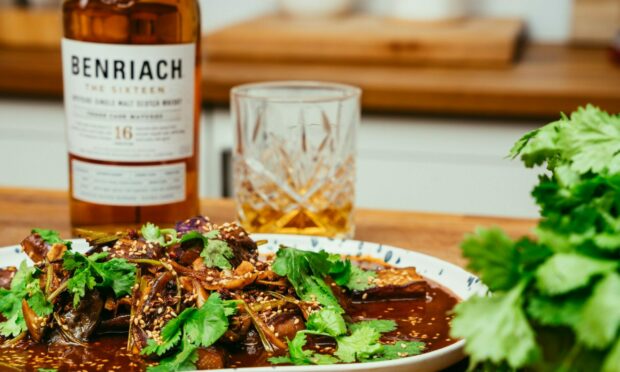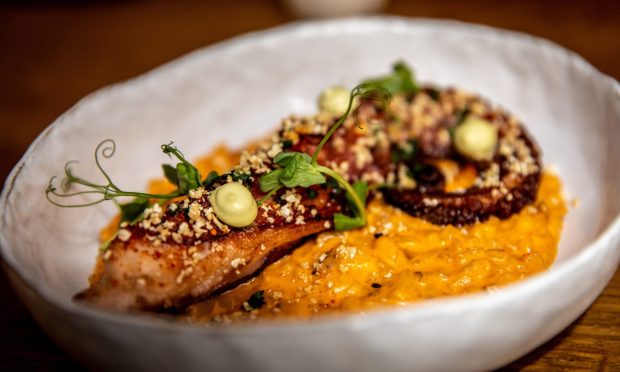This recipe from Julie Lin was created to be paired with whisky-maker Benriach’s The Sixteen.
“I’ve decided to maximise the flavours of Sichuan in this dish, it has such a floral yet prickly note with the spice which complements the lovely stone fruit notes from The Sixteen,” she said.
“The umami saltiness of soy balances out the smoky peaty elements, and chinkiang vinegar (black vinegar) enhances the malt flavour.
“Aubergine is a fantastic vessel to carry flavour, it’s like a sponge and soaks up all of the punchy tastes going on here. The use of purely vegetables in this dish is deliberate to show how we can layer flavour with the malt.
“This dish isn’t shy with the impact of ingredients like dried chillies, floral spicy ginger, fragrant coriander and toasted sesame. All are supposed to be able to stand up to the beautiful autumnal notes of The Sixteen and complement each other so well.
“Food that is paired with whisky doesn’t always need to be delicate, and this dish proves that all of these flavours can sing alongside The Sixteen with great harmony to each element of the food and malt.”
Sichuan fragrant aubergine
(Serves 2)
- 500g Japanese eggplant
- Vegetable oil for frying
- 5cm ginger sliced into matchsticks
- 6 cloves garlic
- 50g coriander (stalks chopped off and saved for cooking, leaves for garnish)
- 2 tbsp sichuan peppercorns
- 200ml mushroom stock
- 2 tbsp chilli paste
- 3 tbsp black Chinese vinegar
- 2 tbsp kecap manis (Indonesian sweet soy)
- 1 tbsp light soy
- 1 tsp sugar
- 1 tsp toasted sesame seeds
Method
- Begin by slicing aubergine in two vertically. Now cut up halves into
4cm chunks. - Using a non-stick pan or wok, begin heating up oil to a medium heat, we want about 100ml in there.
- Get a large plate with a paper towel ready (this will soak up excess oil).
Begin frying off the aubergine in batches. Try not to crowd the pan with too many at a time as they’ll seal rather than fry. - Salt them lightly, fry until golden brown and very tender.
- Remove from the oil and allow to dry. Set aside.
- Now add 2 tbsp of oil to a clean
wok and fry off ginger, garlic and coriander stems (save the leaves for garnishing). - Once fragrant, add Sichuan peppercorns and fry until fragrant. They pop on the oil but make sure they don’t burn.
- Add in all of the wet ingredients, mushroom stock, chilli paste, black vinegar, kecap manis and light soy.
- Now add in sugar and mix everything together until it’s combined.
- Now add in aubergines again, allow them to simmer in the sauce for five minutes, making sure they don’t soften too much.
- Serve garnished with roughly torn coriander leaves and toasted sesame seeds.
For more midweek meal ideas, check out our archive here.











